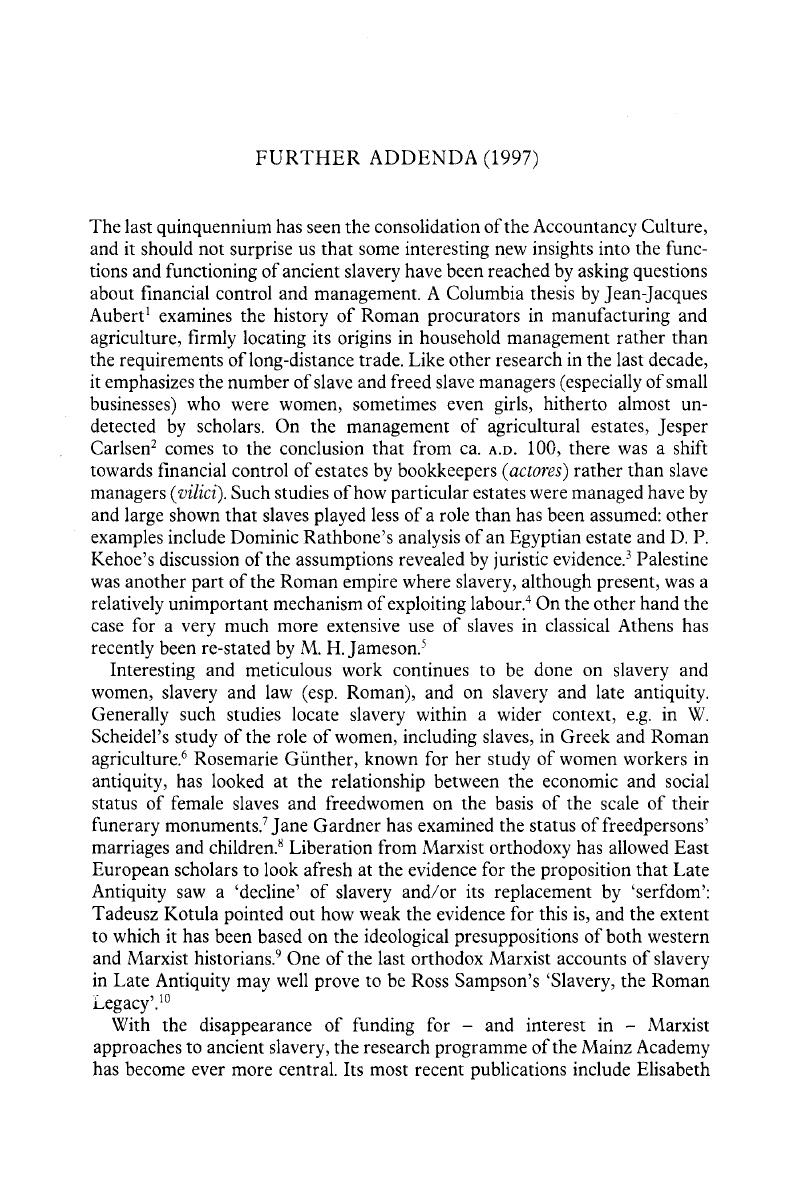No CrossRef data available.
Article contents
Further Addenda (1997)
Published online by Cambridge University Press: 05 February 2016
Abstract

- Type
- Addendum
- Information
- Copyright
- Copyright © Cambridge University Press 1997
References
Notes
1. Aubert, J.-J., Business Managers in Ancient Rome (Leiden, 1994)Google Scholar.
2. Carlsen, J., Vilici and Roman Estate Managers until AD 284 (Rome, 1995)Google Scholar.
3. Rathbone, D., Economie Rationalism and Rural Society in Third-century AD Egypt (Cambridge, 1991)Google Scholar; Kehoe, D. P., ‘Approaches to Profit and Management in Roman Agriculture: the Evidence of the Digest’ in Carlsen, J. (ed.), Landuse in the Roman Empire (Rome, 1994), 45–58 Google Scholar; cf.Scheidel, W., Grund-pacht und Lohnarbeit in der Landwirtschaft des römischen Italien (Frankfurt, 1994)Google Scholar.
4. Safrai, Ze’ev, The Economy of Roman Palestine (London and New York, 1994)CrossRefGoogle Scholar.
5. Jameson, M. H., ‘Agricultural Labor in Ancient Greece’, in Wells, B. (ed.), Agriculture in Ancient Greece (Stockholm, 1992), 135–146 Google Scholar; minimalizing the importance of slavery, see (from a Marxist perspective) Wood, E. M., Peasant Citizen and Slave (London, 1988)Google Scholar and Osborne, R., Demos: the Discovery of Classical Attica (Cambridge, 1985), esp. 142 ff.Google Scholar; see also the discussions by Sallares and Gallant (p. 55 n. 5 above).
6. Scheidel, W., ‘The Most Silent Women of Greece and Rome: Rural Labour and Women’s Life in the Ancient World’, i: G&R 42 (1995), 202-17Google Scholar and ii: G&R 43 (1996), 1–10 Google Scholar.
7. Günther, G., ‘Die Grösse des Grabplatzes von servae und libertae als Ausweis ihrer wirtschaftlichen Lage und sozialen Reputation’, Lavema 1 (1990), 101-28Google Scholar. Cf. her earlier Frauenarbeit – Frauenbindung (Munich, 1987).
8. Gardner, J., ‘Hadrian and the Social Policy of Augustus’, Labeo 42 (1996), 83–100.Google Scholar
9. Kotula, T., ‘Les Grands domaines et l’esclavage face à la “Crise du Ule Siècle”’, Eos 79 (1991), 71–83 Google Scholar; a similar critique of the concept of’latifundia’ would be timely.
10. In Drinkwater, J. & Elton, J. (edd.), Fifth-century Gaul: a Crisis of Identity? (Cambridge, 1992), 218-27Google Scholar; the same volume has an illuminating analysis of the Bagaudae (according to Marxist tradition, rebellious slaves or serfs) as responses by local (Gallic) communities to the collapse of central state authority (pp. 208-17).
11. Herrmann-Otto, E., Ex Ancilla Natus (vol. XXIV, 1994)Google Scholar; Rix, H, Die Termini der Unfreiheil in den Sprachen All-llaliens (vol. XXV, 1994)Google Scholar; Gundlach, R., Die Zwangsumsiedlung auswärtiger Bevölkerung als Mittel ägyptischer Politik bis zum Ende des Mittleren Reiches (vol. XXVI, 1994)Google Scholar; Solin, H., Die römischen Sklavennamen (Beiheft 2, 1995)Google Scholar.
12. Garland, A., ‘Cicero’s Familia Urbana’, G&R 39 (1992), 163–72.Google Scholar
13. Fisher, N., Slavery in Classical Greece (London, 1993)Google Scholar; Bradley, K., Slavery and Society at Rome (Cambridge, 1994)CrossRefGoogle Scholar. The death in 1995 of the leading Polish expert on slavery (especially in Egypt), Professor I. Biezunska-Malowist, should not go unremarked.


